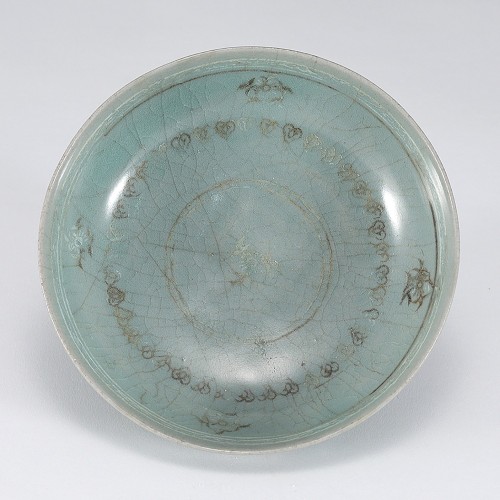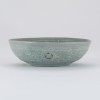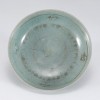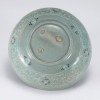본문
외측면선이 완만한 곡선을 이룬 발의 형태입니다. 안쪽 면에는 당초문과 여의두문, 국화문을 상감 기법으로 새겼는데 그 표면 위에 화금으로 표현한 흔적이 남아있습니다. 바깥 면에는 흑백 상감으로 국화와 당초문이 새겨져 있습니다. 굽은 다리 굽이며, 굽 안 바닥의 세 곳에 규석을 받친 흔적이 남아 있습니다. 빙렬이 있는 맑고 투명한 녹청색의 청자 유약이 전면에 입혀져 있습니다.
국화는 절개와 장수, 당초문은 영원한 생명력, 그리고 여의두문은 뜻을 이룬다는 상징을 의미합니다. 화금청자는 순청자 또는 상감청자에 금으로 표면을 장식한 청자로써 고려시기 일부 수요자를 위하여 특별히 만들어진 청자의 일종입니다. 현재 국내에 남아있는 화금청자는 호암미술관, 국립중앙박물관 등 소수의 기관에만 남아 있는 귀한 유물입니다.
━━━━━
本器物为一件器形外缘呈柔和曲线的钵形青瓷。内侧镶嵌技法装饰唐草纹、如意头纹与菊花纹,表面留有以金彩装饰的痕迹。外壁则以黑白相间的象嵌描绘菊花与唐草纹。底足可见三处支烧所留下的硅石支痕。器物整体施以透明而清亮、带有冰裂纹的青绿色釉,呈现出典型高丽青瓷的釉色特色。
菊花寓意节操与长寿,唐草纹象征永恒生命力,如意头纹则代表心愿达成。所谓“镶金青瓷”,是指在纯青瓷或象嵌青瓷的基础上,表面再以金彩加饰的特别制品。此类青瓷为满足特定阶层需求而制作。目前,韩国国内现存的镶金青瓷仅见于湖岩美术馆、国立中央博物馆等少数机构所藏,尤显珍贵。
━━━━━
This is a bowl with a gently curving outer profile. On the inner surface, arabesque patterns, ruyi-head motifs, and chrysanthemum designs were engraved using the inlay technique, with traces of gilding remaining on the surface. The outer surface is decorated with chrysanthemums and arabesque patterns in black-and-white inlay. The foot is a rounded ring shape, and three quartzite spur marks are visible on the inside of the foot. The entire piece is coated with a clear and transparent bluish-green celadon glaze featuring fine crackles.
The chrysanthemum symbolizes integrity and longevity; the arabesque represents eternal vitality; and the ruyi-head motif signifies the fulfillment of one’s wishes. Gilded celadon refers to celadon or inlaid celadon decorated with gold on the surface. These were special pieces made for a select clientele during the Goryeo period. Today, gilded celadon pieces are rare, remaining only in a few institutions such as the Ho-Am Art Museum and the National Museum of Korea.



